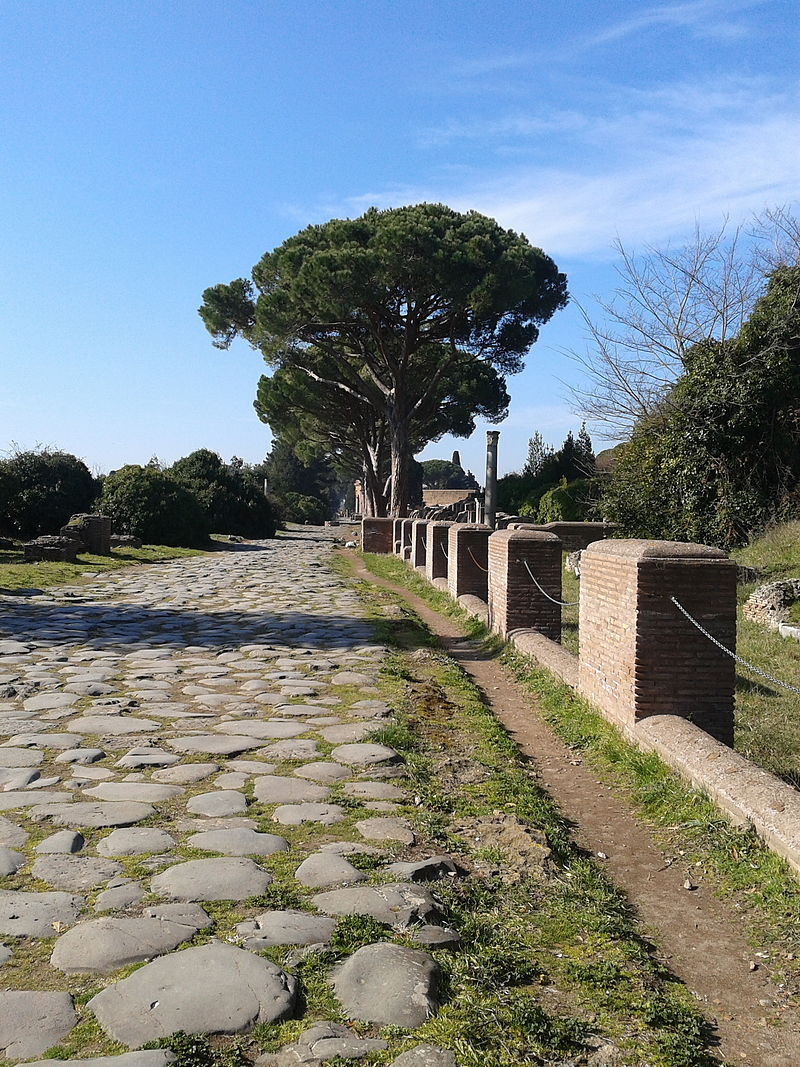Ostia
Location
Ostia is the location of the harbor city of ancient Rome, 15 miles (25 kilometres) southwest of Rome.
"Ostia" (plur. of "ostium") is a derivation of "os", the Latin word for "mouth". At the mouth of the River
Tiber, Ostia is Rome's principle seaport.
History
Origins
Ostia may have been Rome's first colonia. According to legend, Ancus Marcius,
only 17 km (11 mi) from Rome and had a small harbor on the Tiber, and then proceeded
with establishing the new colony 10 km (6 mi) further west and closer to the sea coast.
An inscription seems to confirm the establishment of the old castrum of Ostia in the
7th century BC. The oldest archaeological remains so far discovered date back to only
the 4th century BC. The most ancient buildings currently visible are from the 3rd
century BC, notably the Castrum (military camp); of a slightly later date is the
Capitolium (temple of Jupiter, Juno and Minerva). The opus quadratum of the
walls of the original castrum at Ostia provide important evidence for the building
techniques that were employed in Roman urbanization during the period of the Middle Republic.
Civil Wars
Ostia was a scene of fighting during the period of the civil wars between Gaius Marius and Sulla
during the 1st century BC. In 87 BC, Marius attacked the city in order to cut off the flow of
trade to Rome. Forces led by Cinna, Carbo and Sertorius crossed the Tiber at three points before
capturing the city and plundering it. After his victory here, Marius moved on to attack and capture
Antium, Aricia and Lanuvium to further destroy the food-stores of Rome.
Sacked by Pirates
In 68 BC, the town was sacked by pirates. During the sack, the port was set on fire, the consular
war fleet was destroyed, and two prominent senators were kidnapped. This attack caused such panic
in Rome that Pompey the Great arranged for the tribune Aulus Gabinius to rise in the Roman Forum
and propose a law, the lex Gabinia, to allow Pompey to raise an army and destroy the pirates.
Within a year, the pirates had been defeated. The town was then re-built, and provided with protective
walls by the statesman and orator Marcus Tullius Cicero.
Imperial Ostia
During Julius Caesar's time as Dictator, one of his improvements to the city was his establishment of
better supervision of the supply of grain to Rome. He proposed better access to grain by the use of a
new harbor in Ostia along with a canal from Tarracina.
Under Augustus
At the beginning of the empire, Ostia acquired a new urban aspect: during that period its military
function was left aside, progressively decreased and ended when Augustus moved his fleet to Misenum,
in Campania. Then, the commercial peculiarity of the city prevailed, and soon after the construction
of several large warehouses or barns started, such as the Horrea of Hortensius (Hortensius Warehouse)
and the Big Horrea, along with some already existing warehouses, built during the late Republican period,
among which those along the Decumanus, not far from Piazzale della Vittoria. Augustus had brought about
a dramatic change in the urban city, erecting the theater located along the Decumanus, and redefining its
political, civil and religious center, the Forum, raising a Capitolium at the North end of the square
(that was later replaced by the one which can be seen now, during the reign of Hadrian) and the
Temple of Rome and Augustus, erected during the reign of Tiberius, at the South end of the square.
These two temples represented a clear break with the past, as the sacred buildings of the middle and
late Republic were not only much smaller, but they were made from stuccoed simple materials to create
a faux marble look, while precious marble was copiously used to decorate the new Temple of Rome and Augustus.
Places of Interest
Entering Ostia
- ~ Decumanus Maximus -- The main east–west-oriented road in a Roman city or castrum (military camp).
- ~ The Old City Gate
- ~ Theater of Ostia
- ~ The Forum
- ~ Tiber-side Warehouses
- ~ The Harbor
- ~ The Castrum (fort)
- ~ Old Harbor
- ~ New Harbor
- ~ Tarracina Canal
- ~ Walls of Cicero
Religious Sites
- ~ Capitolium -- Temple of Jupiter, Juno and Minerva -- (north end of the Forum)
- ~ Temple of Rome and Augustus -- (south end of the forum)
- ~ Temple of Cercyon -- East side of the Forum
Trade
Grain is the primary trade item, but a myriad of items from all corners of the Inner Sea
on the docks of the New Harbor.
The Old Harbor has seen the decline in legitimate trade and the rise of illicit goods carried
by smugglers and illegal serviced provided by a growing criminal underworld.
Individuals of Interest
- ~ Agrippa Scaevola -- Gang Leader of Old Harbor
- ~ Verginius Ejiroghene -- Captain of the Petulant Gull
- ~ Caius Cassius -- Architect & Priest of Cercyon
Servants of Harpocrates
- ~ Aemilia Liviana -- Dead woman with cat mask
- - An Unbeliever (Servant of Harpocrates)
- - Sent by the Man in the Owl Mask
- - She joined the mystery cult after the Temple of Aesclepius failed to heal her dying father
- - In joining she renounced her name, national ties, identity and of course, her faith.
Items Carried by Aemilia Liviana
- ~ Cat Mask
- ~ Amulet of Harpocrates
- ~ A Black Silk Fan
- ~ A Knife of Glass
